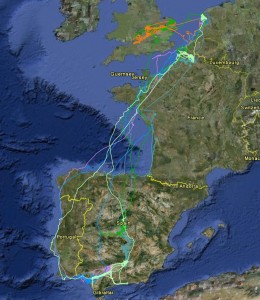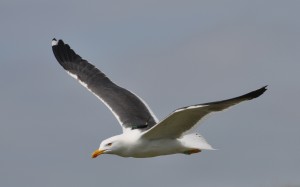Texel gulls back from wintering areas
Species: Lesser Black-backed Gull
Project: Multi-scale movements of gulls from Texel
Spring has clearly begun in the Netherlands and with the onset of spring the Lesser Black-backed Gulls are starting to return to the Kelderhuispolder colony from their wintering areas. As of mid-April 2011, 7 of the 15 birds tagged during the breeding season in 2010 have returned to their colony and all the data stored on the tags (measurements every 10-30 minutes, during the day and at night) between July 2010 and April 2011 were downloaded within a few days after their return. The gulls had visited the UK, Belgium, France, Portugal and Spain and show a diverse array of migration strategies, traveling during the day as well as at night, migrating over water, land, and following coastlines.
.
.
.

Autumn 2010 and spring 2011 migration routes of six Lesser Black-backed Gulls from the Kelderhuispolder breeding colony on Texel, The Netherlands.
Following are a few brief highlights from the diverse migratory movements of these birds. On March 10, 2011 female FAKJ (device 329) started to cross the Bay of Biscay (> 400km) at 20:30 UTC, but stopped flying and spent the night resting on the surface of the water. At 6:30, March 11, 2011, the bird resumed migration and flew at altitudes above 1000 m (at some point the bird even climbed to an altitude of 2 km) and flight speeds ranged between 30 – 75 km/hr. The bird reached the Ile de Oleron, France at 12:30 just in time for a short 2 hour siesta and continued further north until 18:00 when she once again spent the night on the water drifting with the current, starting the next day of migration at 6:00. This bird spent most of her winter in Spain. In contrast female FAKU (device 327) spent the winter in the UK, and although she took her time crossing the North Sea to reach the UK, she returned to the Netherlands, crossing the North Sea in less than two hours at top speeds of over 130 km/hr.
Latest Highlights

Overwintering and foraging areas used by a 24-year old Eurasian spoonbill
Wednesday, April 18th, 2018

Lesser Black-backed Gulls from Schiermonnikoog enjoy their winter holiday
Tuesday, April 3rd, 2018

Oystercatchers returning from inland breeding grounds
Sunday, July 23rd, 2017

GPS tracker with SMS messaging
Monday, November 2nd, 2015

Ronny found back, three years after deployment of the UvA-BiTS GPS-tracker
Wednesday, July 8th, 2015

Lesser Black-backed Gulls feed on potato crisps in Moeskroen
Wednesday, November 13th, 2013

‘Vogel het uit!’ has won the 2013 Academic Year Prize
Tuesday, November 5th, 2013

Back in Europe: UvA-BiTS Honey Buzzard photographed at the Strait of Gibraltar
Wednesday, May 15th, 2013

UvA-BiTS database passes 10 million record mark
Wednesday, May 8th, 2013

Gulls pouring into the Kelderhuispolder colony
Wednesday, April 17th, 2013

To the Karoo and back: Mate replacement & GPS tracking study of an ousted eagle
Monday, March 25th, 2013

Meeting Montagu’s Harrier Edwin in Senegal
Wednesday, March 20th, 2013

Oystercatchers: Learning how and where to survive
Wednesday, August 29th, 2012

New GPS mini-tracker facilitates investigation into movement of smaller animals
Wednesday, July 4th, 2012

Over 5 million GPS fixes in the UvA-BiTS database
Thursday, June 21st, 2012

Tagged Lesser Black-backed Gulls return to Orford Ness
Wednesday, April 18th, 2012

Gulls spotted in their over-wintering areas
Wednesday, December 21st, 2011

The UK a top vacation destination in 2011
Wednesday, July 13th, 2011

A long way from home
Sunday, June 26th, 2011

Visiting Amsterdam for a day
Saturday, May 14th, 2011

Female deserts brood, male raises chicks
Friday, May 13th, 2011

Wintering range in Sierra Leone
Friday, May 13th, 2011

Camera watches foraging Oystercatchers day and night
Thursday, May 12th, 2011

The return of a bird presumed dead
Wednesday, May 11th, 2011

Texel gulls back from wintering areas
Sunday, May 1st, 2011

First Lesser Black-backed Gull returns to the breeding colony
Monday, April 13th, 2009


